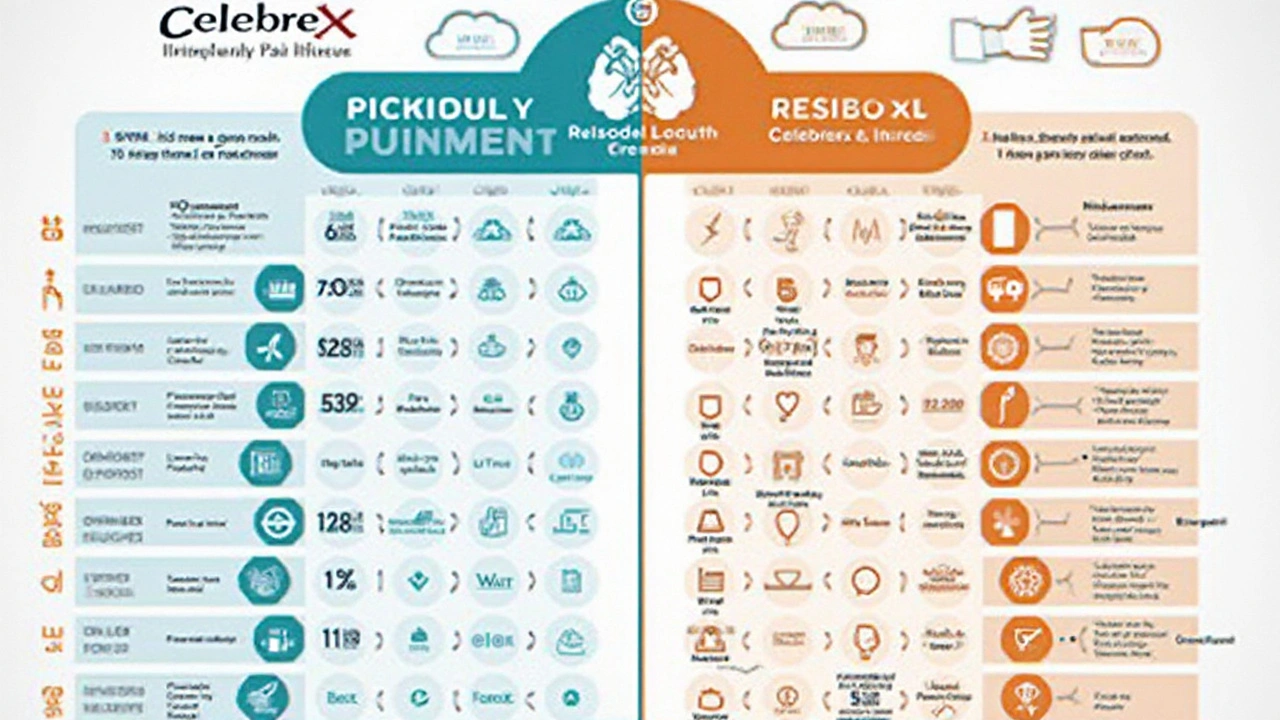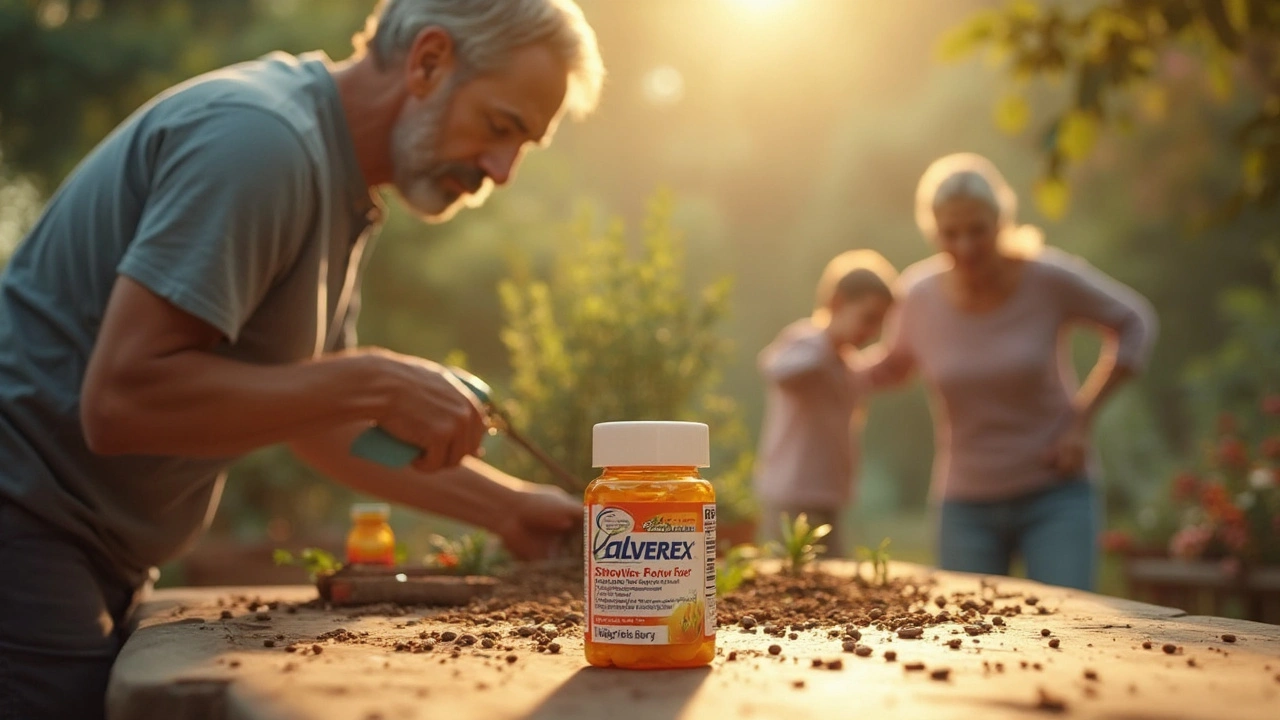Celebrex Uses, Benefits, Side Effects, and Safety Tips

Imagine waking up with aching knees that don’t let you stand up straight, or fingers so stiff it takes effort just to turn a doorknob. That’s daily life for so many people with osteoarthritis or rheumatoid arthritis. That’s where Celebrex comes in—one little pill promising less pain and a lot more freedom. It’s become a quiet hero for folks who need their joints to actually cooperate, but it’s not just another painkiller. There’s a reason doctors in Auckland, New York, and everywhere in between reach for this option. It works differently, sometimes safer, than the over-the-counter painkillers cluttering every pharmacy shelf.
What Is Celebrex and How Does It Work?
Celebrex is the brand name for celecoxib, a prescription drug in the family of nonsteroidal anti-inflammatory drugs (NSAIDs). But here’s the twist—unlike ibuprofen or naproxen, Celebrex is a COX-2 inhibitor. That means it targets a specific enzyme, COX-2, which plays a big part in the inflammation and pain cycle but leaves the COX-1 enzyme (important for stomach and gut health) mostly alone. What does that mean for you? A lower risk of stomach ulcers or bleeding, which is a pretty big deal for anyone who’s already had those awful side effects with traditional NSAIDs.
If you dig into its history, Celebrex got FDA approval back in 1998. It’s stuck around because it tackles the two-headed beast of inflammation and pain in conditions like osteoarthritis, rheumatoid arthritis, juvenile arthritis, ankylosing spondylitis, and even painful menstrual cramps. Doctors also sometimes use it for short-term pain after surgery or sudden injuries. Celebrex doesn’t cure these conditions—it just makes the symptoms less of a daily struggle.
Celebrex usually comes in 100mg and 200mg capsules. The typical dose varies depending on the condition, but it’s often one or two pills per day. It gets to work fast—the medicine reaches its peak effect in about 3-4 hours, meaning you might notice relief before lunchtime. Plus, it doesn’t cause drowsiness, so you can take it in the morning and still be sharp for work or errands.
| Feature | Celebrex | Traditional NSAIDs |
|---|---|---|
| Preserves stomach lining? | Yes (targets COX-2 only) | No (blocks both COX-1 and COX-2) |
| Main uses | Arthritis, acute pain, period pain | Pain, inflammation, fever |
| Risk of ulcers | Lower | Higher |
| Onset of relief | 3-4 hours | 1-2 hours |
Key Uses and Who Should Consider Celebrex
Doctors look to Celebrex for a few big reasons, but the main one is arthritis. In New Zealand, about 670,000 people live with osteoarthritis, and it’s a leading cause of disability among older adults. Celebrex helps manage the joint pain, swelling, and stiffness without hammering the stomach with the same force as some older medications. If you’ve tried ibuprofen or diclofenac but ended up with heartburn (or worse), Celebrex might be a safer bet.
But the list doesn’t stop at just arthritis. Here’s where Celebrex typically shines:
- Osteoarthritis (the wear-and-tear joint kind)
- Rheumatoid arthritis (the immune-driven, swollen joint version)
- Ankylosing spondylitis (basically chronic inflammation of the spine)
- Acute pain from injuries or surgeries
- Painful menstrual cramps (which, let’s be honest, can be truly brutal)
- Familial adenomatous polyposis (a rare reason, but Celebrex can help reduce the number of colon polyps in a few inherited conditions)
Some people notice they get the freedom to walk the dog again or even play with the grandkids without wincing. I’ve got a friend here in Auckland who swears by Celebrex after knee surgery—she says it’s the only thing that let her get out of bed and tackle the rehab exercises, especially when the mornings were the worst.
However, the medicine isn’t right for everyone. People who have had serious heart conditions, recent heart surgery, or allergic reactions to sulfa drugs need to talk with their doctor before starting Celebrex. The same goes for those prone to strokes, stomach bleeding, or high blood pressure that is not well controlled. Pregnant women should avoid Celebrex in the later stages of pregnancy, as it can affect the baby’s circulation. And for people with bad kidney or liver problems, Celebrex may not be safe.
Always double-check with your prescriber if you take other blood-thinners, antidepressants, ACE inhibitors, or diuretics, because drug interactions with Celebrex can seriously mess with your blood pressure, kidneys, or stomach.

Benefits That Make Celebrex Different from Other Painkillers
What makes Celebrex special compared to older painkillers? It’s really about hitting that sweet spot: you want enough pain relief and less risk of bad side effects. For many people, traditional NSAIDs like ibuprofen, naproxen, or diclofenac lead to a whole new set of problems—stomach pain, ulcers, and in rare cases, internal bleeding. Celebrex’s targeted COX-2 action means it’s less harsh on your gut, and that becomes even more important if you’re older, or you have a history of ulcers or are taking other medications that stress your stomach.
Take this: A 2016 New England Journal of Medicine study with over 24,000 arthritis patients compared Celebrex to ibuprofen and naproxen. The rate of stomach and bowel complications was significantly lower for the Celebrex group. Even better, the pain relief scores were just as good. That’s huge for anyone whose doctor has had to say, “You can’t keep taking those NSAIDs, your gut won’t handle it.”
Another unnoticed benefit is Celebrex’s effect on inflammation itself. Unlike simple painkillers like paracetamol (acetaminophen), Celebrex actually tackles the root cause of pain—swelling, redness, and heat in the joints. This means you don’t just mask the pain; you actually turn down the body’s overblown inflammatory response, which can slow down joint damage over time.
It gets even more interesting for people at risk of stomach problems. Some patients who take low-dose aspirin for their heart end up needing NSAIDs for arthritis. Usually, combining two NSAIDs doubles the risk of a bleeding ulcer. With Celebrex, the risk doesn’t jump by nearly as much if you’re careful, though you still need regular checks to stay safe.
The convenience factor is hard to beat. Celebrex only has to be taken once or twice per day, and it can be taken with or without food. There’s a sense of freedom here, especially if you’ve ever had to set alarms just to keep up with pain meds every four hours.
Possible Side Effects and Risks to Watch Out For
Every medicine comes with some baggage, and Celebrex is no exception. Although it spares your stomach more than some NSAIDs, there are still things you should keep on your radar. The most common side effects are mild, like headache, indigestion, gas, diarrhea, or swelling of the hands and feet. For most people, these go away as your body gets used to the medicine.
Rarely, more serious problems can happen. Some folks might develop allergic reactions with hives, rash, or trouble breathing—those are emergencies and need medical attention straight away. Celebrex can raise blood pressure, increase the risk of heart attack or stroke (especially if you already have heart issues), or cause fluid retention. It can also affect the kidneys, especially if you’re taking certain blood pressure meds or you have pre-existing kidney troubles.
There’s also a small but real chance of liver problems. Watch for signs like yellowing of the eyes, dark urine, or unexplained fatigue. If you notice these, get to a doctor quickly. If you’re older or have chronic health issues, ask your GP for blood tests to keep tabs on your kidney and liver function while taking Celebrex.
| Side Effect | How Common? |
|---|---|
| Headache | 6% |
| Indigestion | 5% |
| Diarrhea | 4% |
| High blood pressure | 3% |
| Swelling (ankles/hands) | 2% |
| Rash/allergic reaction | 1% |
If you ever feel chest pain, weakness on one side, shortness of breath, or sudden swelling, that’s the cue to stop Celebrex and call emergency services right away. With any long-term prescription, regular check-ups matter. Stay honest with your doctor if you notice anything unusual, even if it feels embarrassing or weird to mention.
What about drug interactions? Celebrex can interact with blood thinners (like warfarin), SSRIs (antidepressants), lithium, and several blood pressure drugs, increasing your risk for bleeding, kidney issues, or dangerously high blood pressure. Keep an updated medication list—especially if you’re seeing specialists or take over-the-counter supplements.

Tips for Safe and Effective Use of Celebrex
Want to get the best results and avoid problems with Celebrex? Start with communication. Be honest about your medical history, especially if you have heart, liver, or kidney problems—or if you’ve had allergic reactions to medicine before.
Only take Celebrex exactly as your doctor prescribes. Don’t double up if you miss a dose, and never share your pills with friends (it’s tempting, but everyone’s health story is different). Take it with a glass of water, and food is optional—you might find you have fewer stomach grumbles if you take it with breakfast or dinner.
For chronic pain, try tracking your symptoms. A little notepad or an app can help you notice patterns: are you actually improving, or are you just masking pain? This also helps your doctor adjust the dose or try add-on treatments if needed.
Keep up with the routine check-ups and blood tests your GP requests. Sometimes it’s tempting to skip these if you’re feeling better, but this is how doctors catch small problems before they become big trouble.
If you use anti-inflammatory painkillers a lot (say, for sports injuries or chronic conditions), ask your GP about switching things up or trying alternative therapies. Physiotherapy, weight loss, or supportive shoes might help prevent you from relying entirely on pills.
Alcohol and Celebrex don’t play nice together. The risk of stomach bleeding or liver trouble goes up a notch if you’re drinking regularly, especially if your dose is higher or you’ve got other health issues. And if you’re planning surgery or any major dental procedure, tell your healthcare provider you’re on Celebrex—a simple switch a few days before might reduce risks around bleeding, bruising, or slow healing.
Some folks swear by ginger tea, turmeric, or omega-3 supplements along with Celebrex, but check with your doctor before adding new remedies. Even natural products can interact with pain or blood-thinning meds in weird ways.
If you’re ever not sure, or you start to feel like the medicine isn’t helping as much, loop your doctor back into the conversation. Don’t just stop suddenly—this can make pain rebound harder than before.
Below are some useful tips in summary:
- Store Celebrex capsules at room temperature. Keep them dry and away from sunlight.
- Keep out of reach of kids or pets—capsules look like candy to little hands.
- Report side effects even if they seem small; sometimes early clues are the best warnings.
- Watch for any sudden weight gain or ankle swelling, which can signal heart or kidney issues.
- Don’t mix with other NSAIDs unless your doctor insists—double dosing isn’t safer.
Sometimes, using Celebrex means saying yes to the little joys. I remember Caden teasing me about the time I finally outwalked him at the park after I started a short course on Celebrex for my ankle—pain relief gave me a confidence boost and let me enjoy life without nagging aches.
So, if you’re one of the many people in Auckland (or anywhere, really) struggling with aching joints, check with your doctor about celebrex. It’s not magic, but it might just be the leg-up you’ve been looking for, turning pain down a notch and letting those everyday moments feel like yours again.

Monika Wasylewska
May 31, 2025 AT 22:27Celebrex changed my life. My knees used to scream at dawn, now I walk to the café without wincing. Not magic, just science that works.
Thank you for writing this so clearly.
Jackie Burton
June 2, 2025 AT 21:46COX-2 inhibitors were pushed by Big Pharma to replace naproxen after the Vioxx scandal. They knew the cardiovascular risks were just as bad-just slower to show up. The FDA approval was a marketing win, not a medical one. Read the 2004 NEJM follow-ups. They buried the data.
They want you addicted to the pill, not fixing the root cause: inflammation from diet, sedentary life, and toxins.
Don’t be the lab rat.
Philip Crider
June 4, 2025 AT 10:06Bro I’ve been on Celebrex for 3 years now and honestly it’s the only thing that lets me play with my dog without crying 😭
Also I’m from Texas so I know pain. And this ain’t just placebo. I tried turmeric, acupuncture, cryotherapy, even that weird CBD oil that tasted like burnt tires.
Celebrex? It just works. And yeah I know about the heart stuff but my BP’s fine and my doc checks me every 6 months. Y’all are overthinking it.
Also I accidentally took two pills once. No big deal. Just got really sleepy. And hungry. Like, ‘eat the whole pizza’ hungry.
TL;DR: It’s not perfect but it’s better than being a zombie.
Diana Sabillon
June 4, 2025 AT 19:50I just wanted to say thank you to the OP. I’ve been scared to start this med because of all the scary stuff online. Reading your friend’s story about walking the dog again made me cry. I’ve been so isolated since my hip started acting up. Maybe I’ll talk to my doctor this week.
You made someone feel seen.
neville grimshaw
June 6, 2025 AT 17:56Oh for fucks sake, another ‘Celebrex is the answer’ post. I’ve seen this exact article on three different forums. Someone’s clearly being paid. Or it’s a bot trained on WebMD. Either way, the tone is so… *earnest*. Like a pharmaceutical rep trying to sell you a new vacuum cleaner that also cures existential dread.
And don’t get me started on the ‘joy of walking the dog’ narrative. Cute. But I’ve got a 17-year-old Labrador who doesn’t care if I’m in pain-he just wants his treat and to lick my face. That’s not freedom. That’s canine emotional blackmail.
Carl Gallagher
June 6, 2025 AT 23:49I’ve been managing ankylosing spondylitis for over a decade and I’ve tried everything-NSAIDs, DMARDs, biologics, acupuncture, yoga, cold plunges, even that one guy who swore by magnetic knee braces. Celebrex is the only thing that gave me consistent relief without wrecking my stomach. The key, though, is consistency. I take it every day, even if I feel okay. Skipping doses makes the stiffness come back like a freight train. Also, I’ve been on it for six years now and my liver enzymes are fine, my BP is stable, and I still hike every weekend. But I get bloodwork every four months and I don’t drink. Ever. And I don’t take any other NSAIDs-not even aspirin. The discipline matters more than the drug itself. It’s not a miracle, it’s a tool. Use it right.
bert wallace
June 7, 2025 AT 02:05Interesting breakdown. I’ve been on Celebrex since 2019 after my ulcer scare with naproxen. It’s been good. But I’m curious-has anyone here noticed the price jump? My pharmacy just raised it from $12 to $47 for a 30-day supply. That’s not sustainable for most people. I get the science, but the economics? Not so much.
Why are we paying so much for a drug that’s been around since 1998? That’s not innovation. That’s greed.
Neal Shaw
June 7, 2025 AT 22:39There’s a critical nuance missing from this post: Celebrex’s efficacy is dose-dependent and varies by individual pharmacokinetics. The 100mg vs 200mg dosing isn’t arbitrary-it’s based on CYP2C9 metabolism variants. Some patients are poor metabolizers and accumulate toxic levels even at standard doses. Genetic testing (e.g., CYP2C9*2/*3 alleles) can predict adverse events before they occur. Also, the 2016 NEJM study you cited had a 3-year follow-up, but the cardiovascular risk becomes statistically significant after 18 months of continuous use in patients over 65. This isn’t a ‘safe alternative’-it’s a risk-benefit tradeoff requiring personalized assessment. Always pair pharmacological intervention with non-pharmacological modalities. Movement, not medication, is the true long-term solution.
Hamza Asghar
June 9, 2025 AT 02:22LOL you people act like Celebrex is some miracle cure. You know what else reduces inflammation? Not eating processed food. Not being obese. Not sitting on your ass all day. But nooo, let’s just pop a pill and call it a day. And don’t even get me started on the ‘I can walk the dog now’ nonsense. You’re not curing arthritis-you’re masking symptoms while your joints keep degenerating. And the fact that you’re all thanking the OP like he’s a saint? Classic placebo-effect worship. Wake up. Your body is screaming. You’re just drugging it into silence. And you’re paying $50 a month to do it. You’re not a patient. You’re a customer.
Karla Luis
June 10, 2025 AT 14:24So you’re telling me I can take this and not die but also not move without screaming and also pay $47 a month and still be expected to ‘live my best life’? Sweet. Just add it to my list of things that are ‘better than nothing’ but still make me want to scream into a pillow. Thanks for the info I guess. Next up: how to cry quietly while taking a pill that costs more than my rent